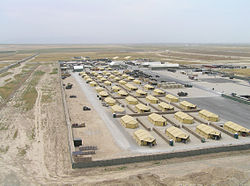

A Hesco bastion, [1] also known as a Hesco barrier, [2] and formally Concertainer, [3] is a gabion introduced in 1989 and primarily used for flood control and military fortifications. [4] It is made of a collapsible wire mesh container and heavy-duty geotextile fabric liner and is used as a temporary to semi-permanent levee or blast wall against small-arms fire or explosives. It has been used in military applications in Iraq and Afghanistan.

